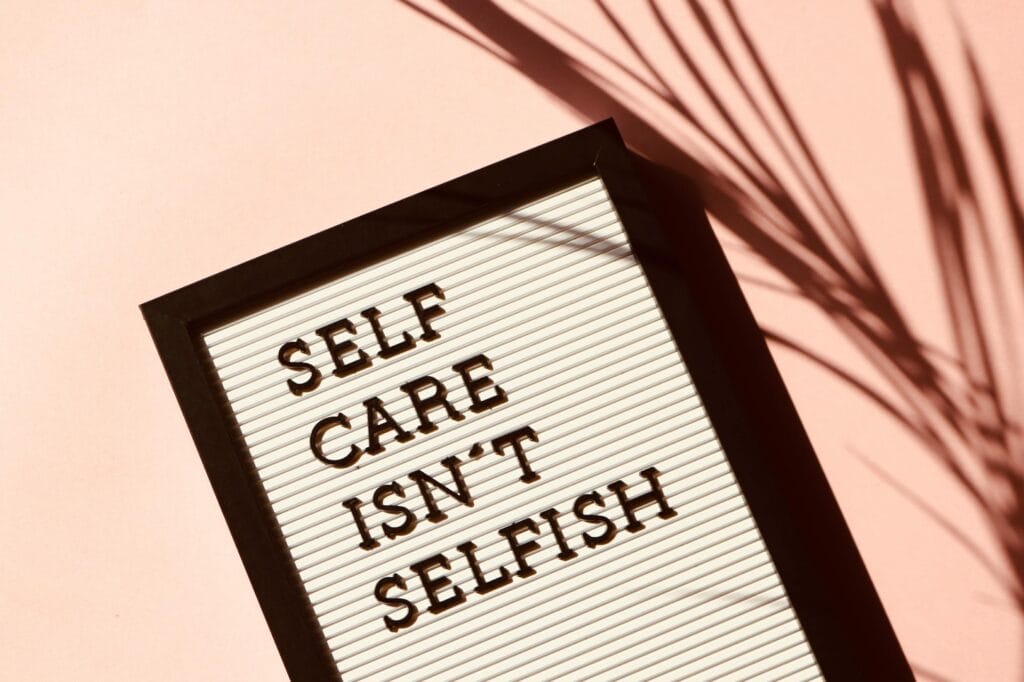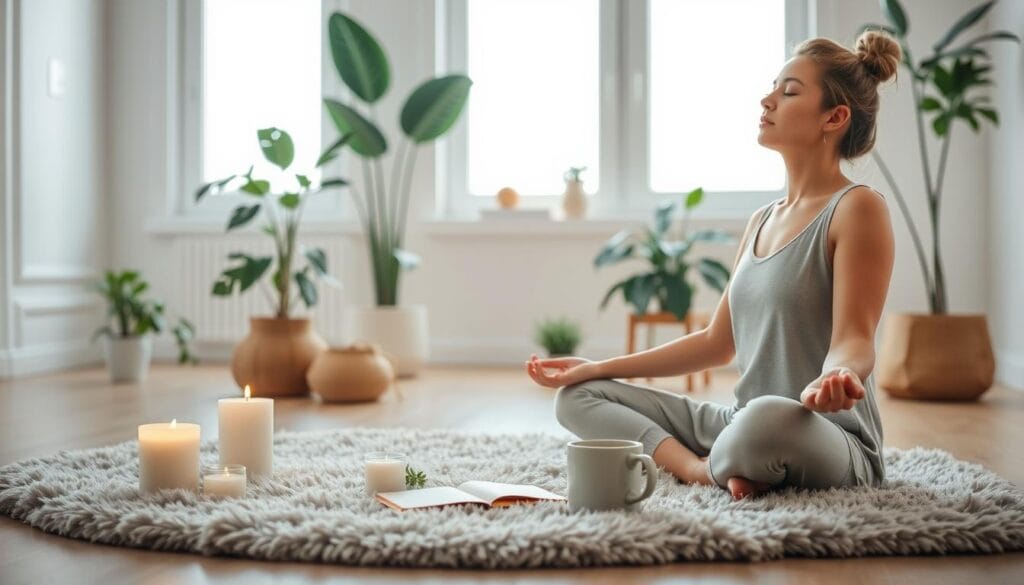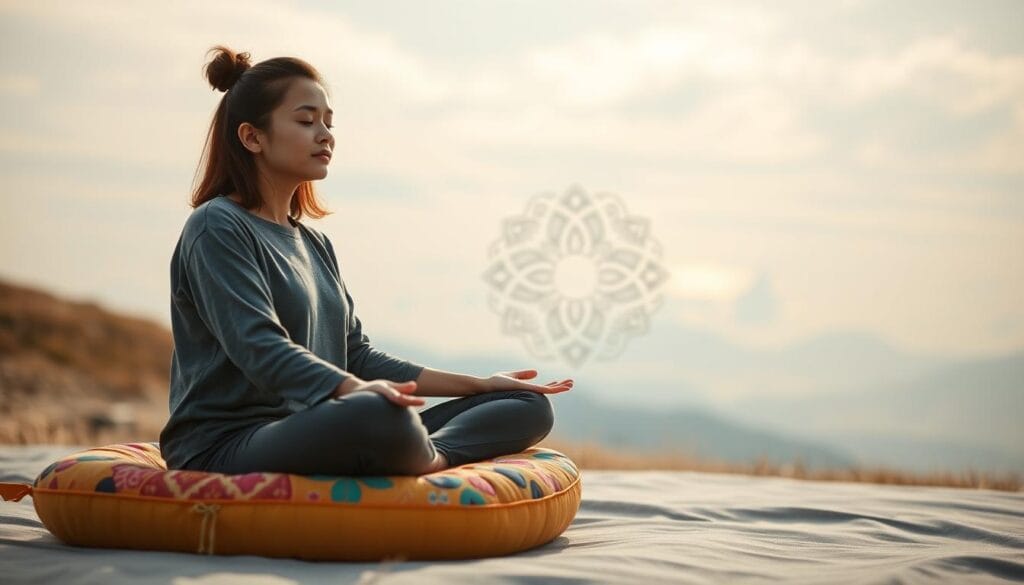As an Amazon Associate I earn from qualifying purchases.
7 Ways to Boost Mental Health & Calm Anxiety
Reflecting on my journey with anxiety, I see it’s a common challenge. Daily life’s pressures can feel overwhelming. Simple yet powerful practices have greatly improved my mental health.
By adopting self-care practices and being mindful, we can better face life’s challenges. This article will share effective strategies for managing anxiety and enhancing mental health.
Key Takeaways
- Discover simple yet effective self-care practices to reduce anxiety
- Learn how to incorporate mindful reminders into your daily routine
- Understand the importance of mental health tips for overall well-being
- Explore strategies to boost your mental health and resilience
- Find practical ways to manage anxiety and improve your quality of life

The Power of Mindfulness in Managing Anxiety
Mindfulness is changing how we deal with anxiety, leading to a calmer mind. It focuses on the present, helping us avoid worries about the past or future. These worries often cause anxiety.
How Mindfulness Affects Your Brain
Mindfulness changes how our brain works, helping us feel less anxious. It lowers stress hormones, such as cortisol, making us feel calmer. It also improves our brain’s ability to handle emotions, helping us manage anxious thoughts better.
Why These 7 Reminders Can Transform Your Mental Health
The seven mindful reminders in this article help you use mindfulness techniques daily. They offer a complete way to handle anxiety. By following these reminders, you can become more resilient against anxiety and boost your mental health.
These reminders are easy to use and fit into your daily life. They help you find calm and reduce anxiety.
7 Mindful Reminders to Ease Anxiety and Boost Your Mental Health
Modern life can be tough, but mindful reminders can help. Mindfulness means being in the now. It can cut down stress.
Overview of the Mindful Approach
Mindfulness is about being aware of the present. It uses meditation and deep breathing. This helps manage stress before it turns into anxiety.
Key elements of the mindful approach include:
- Being present and fully engaged in the current moment
- Acknowledging thoughts and feelings without judgment
- Practicing gratitude and self-compassion
How to Implement These Reminders in Your Daily Life
Adding mindful reminders to your day is easy and beneficial. Start by making a mindfulness schedule that works for you.
Creating a Mindfulness Schedule
Find times each day for mindfulness, like in the morning or before bed. This makes it a habit.
Tracking Your Progress
Keeping track of your mindfulness is key. Use a journal or app to log your practices. It helps you see how far you’ve come.
By using these reminders and tracking your progress, you’ll handle anxiety better. As Jon Kabat-Zinn said,
“The best way to take care of the future is to take care of the present moment.”
Mindful Reminder #1: Breathe Consciously Through Difficult Moments
When anxiety hits, conscious breathing can calm your mind. This simple method is a big help in managing anxiety.
The 4-7-8 Breathing Technique Step-by-Step
The 4-7-8 breathing technique, also known as the “Relaxation Breath,” is easy to do. It involves breathing in through your nose, holding it, and then exhaling through your mouth. Here’s how to do it:
- Breathe in through your nose for a count of 4.
- Hold your breath for a count of 7.
- Exhale through your mouth for a count of 8.
When and How to Implement Conscious Breathing
Conscious breathing can be used at different times to help with anxiety.
Morning Anxiety Management
Starting your day with conscious breathing can make a big difference. It helps manage morning anxiety and gets you ready for the day.
Midday Stress Relief
Conscious breathing in the middle of the day can give you a break. It helps reduce stress.
| Breathing Technique | Benefits | Best Time to Practice |
|---|---|---|
| 4-7-8 Breathing | Reduces anxiety, promotes relaxation | Morning, Midday, Before Bed |
| Conscious Breathing | Calms the mind, reduces stress | Anytime, Specialy During Stress |
Mindful Reminder #2: Ground Yourself in the Present Moment
By focusing on the present, you can find calm in chaos. Grounding techniques help you move away from worries and into the now.
The 5-4-3-2-1 Sensory Grounding Exercise
This exercise is easy yet powerful. It asks you to notice:
- 5 things you can see around you
- 4 things you can touch or feel
- 3 things you can hear
- 2 things you can smell
- 1 thing you can taste
This exercise distracts you from worries and brings you back to the present.
Creating Grounding Rituals for Daily Life
Grounding rituals can be part of your daily routine. They can be physical or mental.
Physical Grounding Techniques
Physical techniques use your senses to connect with now. Examples include:
| Technique | Description |
|---|---|
| Walking barefoot | Feeling the ground beneath your feet |
| Holding a comforting object | Focusing on the texture and weight |
| Deep breathing exercises | Paying attention to the sensation of breath |
Mental Grounding Practices
Mental practices distract you from anxiety. Examples include:
- Counting backwards from 100
- Reciting a poem or song lyrics
- Focusing on a simple task like folding laundry
By adding these techniques to your day, you can manage anxiety better and feel calmer.
Mindful Reminder #3: Accept Your Feelings Without Judgment
Accepting our emotions without judgment is key to mental wellness. When we let ourselves feel without criticism, we open up to healing and emotional processing.
Practicing Emotional Awareness
Emotional awareness is the first step to accepting our feelings. It means knowing and understanding our emotions without trying to change them right away. This helps us have a better relationship with our feelings.
The RAIN Method for Processing Difficult Emotions
The RAIN method is a mindfulness technique for dealing with tough emotions. RAIN stands for Recognize, Allow, Investigate, and Nurture.
Recognizing Your Emotional State
The first step in the RAIN method is to recognize our emotional state. This means acknowledging how we feel right now without judgment. It helps us understand our emotional landscape.
Allowing Emotions to Exist Without Resistance
The next step is to allow our emotions to be without trying to change them. This can be hard but is essential for healing and processing.
By using the RAIN method and being more aware of our emotions, we can be kinder and more accepting of them. This improves our mental health and well-being.
Mindful Reminder #4: Practice Self-Compassion During Anxious Moments
Self-compassion is key to easing anxiety. When we’re anxious, we often criticize ourselves, making things worse. Treating ourselves with kindness, like we would a friend, is crucial.
Self-Compassion Phrases to Memorize
Memorizing and repeating certain phrases can help. These phrases calm our minds and hearts. Here are a few examples:
- “May I be kind to myself.”
- “May I be at peace.”
- “I am doing the best I can.”

Treating Yourself as You Would a Friend
Being kind to yourself means being gentle and understanding, even when it’s hard. It’s important to remember that suffering is a natural part of life.
Recognizing Common Humanity in Suffering
Knowing we’re not alone in our struggles can be very comforting. It makes us feel more connected and less alone.
Replacing Self-Criticism with Kindness
When self-criticism pops up, we can choose kindness instead. It’s about accepting our flaws and being gentle with ourselves.
By adding self-compassion to our daily lives, we build a better relationship with ourselves. This leads to less anxiety and better mental health.
Mindful Reminder #5: Detach from Anxious Thoughts Through Observation
Learning to observe your thoughts without getting caught up in them is key to managing anxiety. This mindfulness trick helps you stay separate from anxious thoughts. It lessens their effect on your mind.
The Leaves on a Stream Visualization
Try the “leaves on a stream” visualization to detach from anxious thoughts. Picture yourself by a calm stream. See your thoughts as leaves floating by. Let them go without trying to hold onto them.
Creating Distance Between You and Your Thoughts
It’s important to keep a distance from your thoughts to manage anxiety. By watching your thoughts without judgment, you see them as just mental ideas. They don’t reflect reality.
Naming Your Thoughts as They Arise
Labeling your thoughts helps you detach from them. Say “thinking” or “anxiety” when a thought pops up. This simple step shows the thought isn’t a fact but a mental creation.
Watching Thoughts Without Engaging
To detach from anxious thoughts, watch them without getting involved. Think of it like watching TV without getting caught up in the story. See your thoughts as a show on a screen, without reacting.
| Mindfulness Technique | Description | Benefit |
|---|---|---|
| Leaves on a Stream Visualization | Visualize thoughts as leaves on a stream, allowing them to drift away. | Reduces entanglement with anxious thoughts. |
| Naming Thoughts | Label thoughts as they arise. | Creates distance between you and your thoughts. |
| Watching Thoughts Without Engaging | Observe thoughts without interacting with them. | Decreases the emotional impact of anxious thoughts. |
By using these mindfulness techniques daily, you can improve your relationship with your thoughts. This can help reduce anxiety.
Mindful Reminder #6: Connect with Your Body Through Gentle Movement
I’ve found that gentle movement helps me stay grounded and centered, even on the most chaotic days. By connecting with my body, I can ease anxiety and improve my overall mental health.
Simple Yoga Poses for Anxiety Relief
Simple yoga poses can be incredibly effective for anxiety relief. Poses like Child’s Pose and Downward-Facing Dog help calm the mind and soothe the body. These poses encourage deep breathing and relaxation, making them perfect for anxious moments.
Mindful Walking Practice
Mindful walking is another powerful tool for anxiety relief. By paying attention to each step, the sensation of my feet touching the ground, and the rhythm of my breath, I can bring myself into the present moment. This practice helps me let go of worries about the past or future.
Body Scan Meditation Technique
Body scan meditation involves lying down or sitting comfortably and bringing awareness to different parts of my body, starting from my toes and moving up to my head. This practice helps me release physical tension and promotes relaxation.
Incorporating Movement Breaks Throughout Your Day
Incorporating short movement breaks throughout the day can also help reduce anxiety. Simple stretches or a short walk can make a big difference.
By integrating these gentle movement practices into my daily routine, I can better manage anxiety and improve my mental well-being.
Mindful Reminder #7: Create Mindful Moments in Everyday Activities
Adding mindfulness to our daily tasks can boost our mental health. Being present in our daily activities helps us feel less anxious. It also improves our mental well-being.
Transforming Routine Tasks into Mindfulness Practices
Even simple tasks like washing dishes or taking a shower can be mindful moments. Focus on the sensations, sights, and sounds. For example, notice the water’s feel, the suds’ sound, and the soap’s smell while washing dishes.
Finding Moments of Presence in a Busy Day
Even with a busy schedule, we can find moments for mindfulness. Waiting in line, taking a short break at work, or during a phone call are great chances. They help us stay present in our day.
Mindful Eating Exercise
Mindful eating means fully enjoying your food. Notice the colors, smells, textures, and tastes. Try eating a raisin slowly to feel this practice.
Mindful Listening and Communication
Mindful listening is about really listening to what’s being said. Pay attention to the speaker’s tone, pitch, and volume. This can make your relationships better and reduce misunderstandings.
| Mindfulness Practice | Daily Activity | Benefits |
|---|---|---|
| Mindful Eating | Eating a meal or snack | Improved digestion, appreciation for food |
| Mindful Listening | Conversing with someone | Better understanding, improved relationships |
| Mindful Movement | Walking, stretching | Reduced stress, increased awareness |
Conclusion: Your Journey to a Calmer Mind and Healthier Mental State
As we wrap up our look at 7 mindful reminders, it’s clear they can change your life. Adding these self-care habits to your day can greatly improve your well-being. By focusing on breathing, grounding, emotional awareness, self-compassion, and movement, you can find peace and better mental health.
Consistency is key to seeing these benefits. Keep practicing these mindfulness tips. Be patient and kind to yourself as you make them a part of your daily life. This way, you’ll face life’s ups and downs with more ease, clarity, and strength.
FAQ
What are mindful reminders, and how can they help with anxiety?
Mindful reminders are simple practices that help you stay present. They reduce anxiety and improve your mental health. By using these reminders daily, you can become more aware of yourself. This helps calm your mind and handle tough situations better.
How do I start practicing mindfulness, and what’s the best way to get started with the 7 mindful reminders?
To start mindfulness, pick reminders that feel right to you, like breathing or grounding. Start with short sessions and grow as you get more comfortable. Guided exercises and apps like Headspace or Calm can also help.
Can mindfulness practices, such as the 4-7-8 breathing technique, really help reduce anxiety?
Yes, practices like the 4-7-8 breathing technique can greatly reduce anxiety. They slow your breathing and focus on the now. This calms your nervous system, lowers stress hormones, and makes you feel more centered.
How can I incorporate mindful moments into my busy daily routine?
To add mindful moments to your day, turn everyday tasks into mindfulness exercises. Focus on your senses while eating, walking, or showering. Schedule short mindfulness breaks to stretch, breathe, or pause.
Are there any additional resources or tools that can support my mindfulness practice?
Yes, many resources can help your mindfulness practice. There are guided meditation apps, mindfulness journals, and online courses. You can also join local groups, yoga classes, or workshops to connect with others and deepen your practice.
How long does it take to see the benefits of mindfulness practice, and what can I expect?
The benefits of mindfulness vary, but many feel calm and clear within weeks. With regular practice, you can see less anxiety, better emotional control, and overall well-being.
Amazon and the Amazon logo are trademarks of Amazon.com, Inc or it's affiliates.
Related Posts
- Probiotic Foods Boost Digestive Health
Probiotic Foods Boost Digestive Health Healthy Gut Microbiome Introduction: The Importance of Gut Health Your…
- How to Cope with Anxiety
Coping with Anxiety Strategies for Success In today's fast-paced world, where stress and uncertainty often…
- Amazing Top 10 Superfoods to Boost Your Immune System
Amazing Top 10 Superfoods to Boost Your Immune System Maintaining a robust immune system is…






